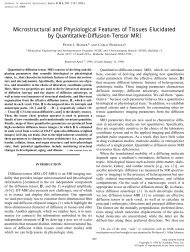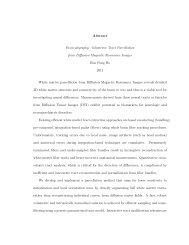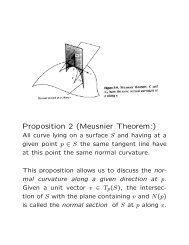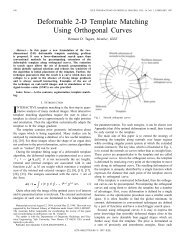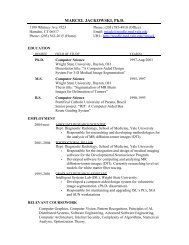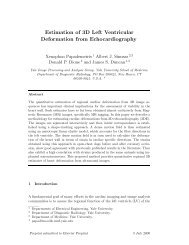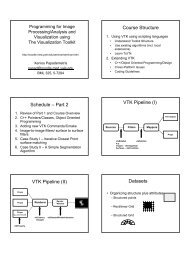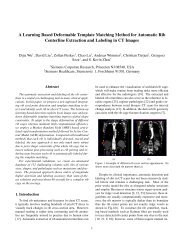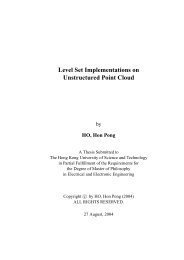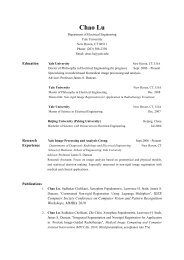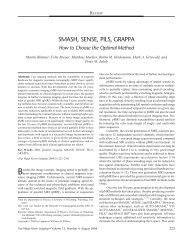Pulsed-field gradient nuclear magnetic resonance as a tool for ...
Pulsed-field gradient nuclear magnetic resonance as a tool for ...
Pulsed-field gradient nuclear magnetic resonance as a tool for ...
You also want an ePaper? Increase the reach of your titles
YUMPU automatically turns print PDFs into web optimized ePapers that Google loves.
220<br />
PRICE<br />
cluding the presence of a background <strong>gradient</strong>,<br />
Ž .<br />
we obtain 45, 86<br />
ž / 0 1 2 1 <br />
SŽ 0. ž<br />
21 2 2<br />
Ž . 2 2 Ž . 2 2 2<br />
S 2 exp exp g D 2 3 g D Ž 3.<br />
2 T2 T1 3 g 0term<br />
g0 term<br />
/<br />
2<br />
2 2 2 Ž . 2<br />
gg D t t t t 2Ž .<br />
0 1 2 1 2 1 2 1<br />
3<br />
where t21t 1.<br />
The same simplifications<br />
can be applied <strong>as</strong> in the c<strong>as</strong>e of Eq. 34 .<br />
By<br />
comparing Eqs. 34 and 36 ,<br />
and by realizing<br />
that the duration in the Stejskal and Tanner<br />
sequence is generally much longer than 1 in the<br />
STE sequence, it can be seen that the l<strong>as</strong>t term in<br />
Eq. 36 Ži.e., 2Ž . .<br />
1 2 1 is much smaller than<br />
Ž 2 the corresponding term in Eq. 34 i.e., 2 . ;<br />
thus, the effect of the cross-term g g 0 is smaller<br />
<strong>for</strong> the STE sequence Ž 86 . . As an <strong>as</strong>ide, we note<br />
that the effects of background <strong>gradient</strong>s can, of<br />
course, also be included with the shaped <strong>gradient</strong><br />
pulse versions of the Stejskal and Tanner sequences<br />
given in Modulated Gradients, or similarly<br />
with the STE sequence.<br />
In the c<strong>as</strong>e of nonuni<strong>for</strong>m <strong>gradient</strong>s, when the<br />
² 2 : 12<br />
equality g g 0 is not met, the interpretation<br />
of Eq. 34 Žor 36. becomes very difficult<br />
Ž 70, 87 . . If the distribution of g 0 is symmetric<br />
about g0 0 and not too large, a series expansion<br />
can be used to correct <strong>for</strong> the background<br />
<strong>gradient</strong>s Ž 81 . . Perhaps counterintuitively, the<br />
me<strong>as</strong>ured diffusion in the presence of internal<br />
<strong>gradient</strong>s is often found to be lower than the<br />
actual diffusion coefficient Ž 87, 88 . . The re<strong>as</strong>on<br />
<strong>for</strong> this is the following. The me<strong>as</strong>ured diffusion<br />
is in essence an ensemble average, and the internal<br />
<strong>gradient</strong>s will weight this distribution at the<br />
time of signal acquisition, since the degree of<br />
deph<strong>as</strong>ing caused by the internal <strong>gradient</strong>s is a<br />
function of the diffusivity. The f<strong>as</strong>ter diffusing<br />
spins will be more attenuated, and consequently it<br />
is the more slowly diffusing spins that contribute<br />
most to the echo signal Ž 87 . . This is analogous to<br />
the effect found <strong>for</strong> spins diffusing in a restricted<br />
geometry having an absorbing wall Ž 89 . . Since the<br />
attenuation due to the background <strong>gradient</strong>s may<br />
be indistinguishable from the attenuation due to<br />
the applied <strong>gradient</strong>, the effects of background<br />
<strong>gradient</strong>s can be mistaken <strong>for</strong> restricted diffu-<br />
Ž .<br />
sion 75 .<br />
<br />
gg cross-terms <br />
0 36<br />
The b<strong>as</strong>is of most sequences <strong>for</strong> the removal of<br />
the g 0 term is to add additional pulses to the<br />
PFG sequence to refocus the deph<strong>as</strong>ing effects of<br />
g 0 in a way analogous to the CPMG sequence<br />
Ž 90 . . Clearly, such sequences must be designed<br />
with an odd number of pulses between the<br />
<strong>gradient</strong> pulses, since an even number of pulses<br />
would simply result in the effects of the second<br />
<strong>gradient</strong> pulse adding to the deph<strong>as</strong>ing effects of<br />
the first <strong>gradient</strong> pulse Ž 90 . . However, removal of<br />
the g g 0 cross-term is more problematic. As<br />
noted above, one solution to the background <strong>gradient</strong><br />
problem is to use applied <strong>gradient</strong>s that are<br />
much larger than the background <strong>gradient</strong>s. When<br />
this is not possible, more sophisticated pulse sequences<br />
must be used. In 1980, Karlicek and<br />
Lowe Ž 91. proposed the use of alternating Žbi-<br />
polar. pulsed-<strong>field</strong> <strong>gradient</strong>s in a modified<br />
CarrPurcell sequence Fig. 17Ž A. to eliminate<br />
the contribution of the g g 0 cross-term, since the<br />
number of positive g intervals equals the number<br />
of negative g intervals. The attenuation due to<br />
diffusion <strong>for</strong> the Karlicek and Lowe sequence can<br />
be calculated using the theory developed in the<br />
first article Žsee<br />
Part 1, The Macroscopic Approach.<br />
to be Ž 91.<br />
ž<br />
2<br />
2 2 3<br />
3<br />
0<br />
EŽ g,2n. exp D ng Ž n1.<br />
3<br />
2<br />
Ž .<br />
2<br />
1 2<br />
g ž 2 /<br />
ž / /<br />
Ž . 1 2<br />
37 2<br />
Ž n1.<br />
where the integer n, 1, and 2 are defined in Fig.<br />
17Ž A . . Systematic errors due to the cross-term<br />
can also be eliminated in a CarrPurcell se-



